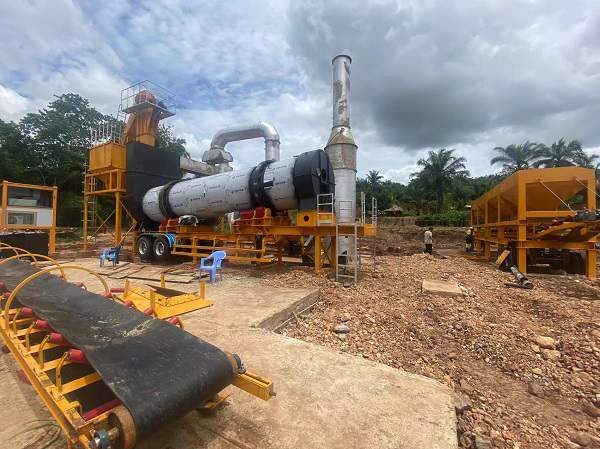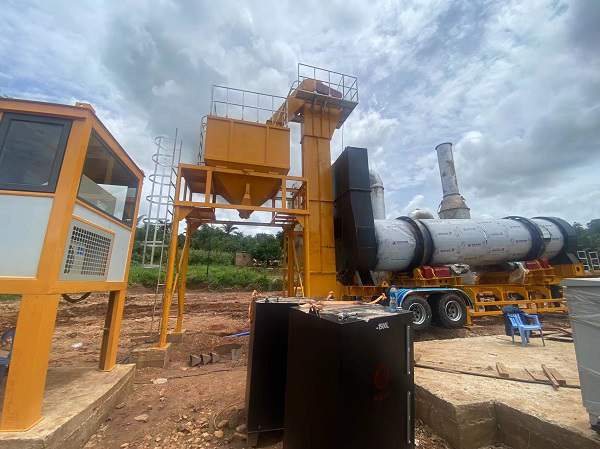The formation, influence and solution of heat transfer oil coking in asphalt mixing plant
[1]. Introduction
Compared with traditional heating methods such as direct heating and steam heating, heat transfer oil heating has the advantages of energy saving, uniform heating, high temperature control accuracy, low operating pressure, safety and convenience. Therefore, since the 1980s, the research and application of heat transfer oil in my country has developed rapidly, and has been widely used in various heating systems in chemical industry, petroleum processing, petrochemical industry, chemical fiber, textile, light industry, building materials, metallurgy, grain, oil and food processing and other industries.
This article mainly discusses the formation, hazards, influencing factors and solutions of coking of heat transfer oil during use.
[2]. Formation of coking
There are three main chemical reactions in the heat transfer process of heat transfer oil: thermal oxidation reaction, thermal cracking and thermal polymerization reaction. Coking is produced by thermal oxidation reaction and thermal polymerization reaction.
Thermal polymerization reaction occurs when heat transfer oil is heated during the operation of the heating system. The reaction will generate high-boiling macromolecules such as polycyclic aromatic hydrocarbons, colloids and asphaltene, which gradually deposit on the surface of the heater and pipeline to form coking.
Thermal oxidation reaction mainly occurs when the heat transfer oil in the expansion tank of the open heating system contacts the air or participates in the circulation. The reaction will generate low-molecular or high-molecular alcohols, aldehydes, ketones, acids and other acidic components, and further generate viscous substances such as colloids and asphaltene to form coking; thermal oxidation is caused by abnormal conditions. Once it occurs, it will accelerate thermal cracking and thermal polymerization reactions, causing the viscosity to increase rapidly, reducing the heat transfer efficiency, causing overheating and furnace tube coking. The acidic substances produced will also cause equipment corrosion and leakage.
[3]. Hazards of coking
The coking generated by the heat transfer oil during use will form an insulation layer, causing the heat transfer coefficient to decrease, the exhaust temperature to increase, and the fuel consumption to increase; on the other hand, since the temperature required by the production process remains unchanged, the temperature of the heating furnace tube wall will rise sharply, causing the furnace tube to bulge and rupture, and eventually burn through the furnace tube, causing the heating furnace to catch fire and explode, causing serious accidents such as personal injury to equipment and operators. In recent years, such accidents have been common.


[4]. Factors affecting coking
(1) Heat transfer oil quality
After analyzing the above coking formation process, it is found that the oxidation stability and thermal stability of heat transfer oil are closely related to the coking speed and quantity. Many fire and explosion accidents are caused by the poor thermal stability and oxidation stability of heat transfer oil, which causes serious coking during operation.
(2) Design and installation of heating system
The various parameters provided by the heating system design and whether the equipment installation is reasonable directly affect the coking tendency of heat transfer oil.
The installation conditions of each equipment are different, which will also affect the life of heat transfer oil. Equipment installation must be reasonable and timely rectification is required during commissioning to extend the life of heat transfer oil.
(3) Daily operation and maintenance of heating system
Different operators have different objective conditions such as education and technical level. Even if they use the same heating equipment and heat transfer oil, their control level of heating system temperature and flow rate is not the same.
Temperature is an important parameter for thermal oxidation reaction and thermal polymerization reaction of heat transfer oil. As the temperature rises, the reaction rate of these two reactions will increase sharply, and the coking tendency will also increase accordingly.
According to the relevant theories of chemical engineering principles: as the Reynolds number increases, the coking rate slows down. The Reynolds number is proportional to the flow rate of the heat transfer oil. Therefore, the greater the flow rate of the heat transfer oil, the slower the coking.
[5]. Solutions to coking
In order to slow down the formation of coking and extend the service life of heat transfer oil, measures should be taken from the following aspects:
(1) Select heat transfer oil of appropriate brand and monitor the trend of its physical and chemical indicators
Heat transfer oil is divided into brands according to the use temperature. Among them, mineral heat transfer oil mainly includes three brands: L-QB280, L-QB300 and L-QC320, and their use temperatures are 280℃, 300℃ and 320℃ respectively.
The heat transfer oil of appropriate brand and quality that meets the SH/T 0677-1999 "Heat Transfer Fluid" standard should be selected according to the heating temperature of the heating system. At present, the recommended use temperature of some commercially available heat transfer oils is quite different from the actual measurement results, which misleads users and safety accidents occur from time to time. It should attract the attention of the majority of users!
The heat transfer oil should be made of refined base oil with excellent thermal stability and high-temperature antioxidants and anti-scaling additives. The high-temperature antioxidant can effectively delay the oxidation and thickening of the heat transfer oil during operation; the high-temperature anti-scaling agent can dissolve the coking in the furnace tubes and pipelines, disperse it in the heat transfer oil, and filter it through the bypass filter of the system to keep the furnace tubes and pipelines clean. After every three months or six months of use, the viscosity, flash point, acid value and carbon residue of the heat transfer oil should be tracked and analyzed. When two of the indicators exceed the specified limit (carbon residue not more than 1.5%, acid value not more than 0.5mgKOH/g, flash point change rate not more than 20%, viscosity change rate not more than 15%), it should be considered to add some new oil or replace all the oil.
(2) Reasonable design and installation of heating system
The design and installation of the heat transfer oil heating system should strictly follow the hot oil furnace design regulations formulated by the relevant departments to ensure the safe operation of the heating system.
(3) Standardize the daily operation of the heating system
The daily operation of the thermal oil heating system should strictly follow the safety and technical supervision regulations for organic heat carrier furnaces formulated by the relevant departments, and monitor the changing trends of parameters such as the temperature and flow rate of the thermal oil in the heating system at any time.
In actual use, the average temperature at the outlet of the heating furnace should be at least 20℃ lower than the operating temperature of the heat transfer oil.
The temperature of the heat transfer oil in the expansion tank of the open system should be lower than 60℃, and the temperature should not exceed 180℃.
The flow rate of the heat transfer oil in the hot oil furnace should not be lower than 2.5 m/s to increase the turbulence of the heat transfer oil, reduce the thickness of the stagnant bottom layer in the heat transfer boundary layer and the convective heat transfer thermal resistance, and improve the convective heat transfer coefficient to achieve the purpose of enhancing fluid heat transfer.
(4) Cleaning of the heating system
The thermal oxidation and thermal polymerization products first form polymerized high-carbon viscous substances that adhere to the pipe wall. Such substances can be removed by chemical cleaning.
The high-carbon viscous substances further form incompletely graphitized deposits. Chemical cleaning is only effective for the parts that have not yet been carbonized. Completely graphitized coke is formed. Chemical cleaning is no longer a solution to this type of substance. Mechanical cleaning is mostly used abroad. It should be checked frequently during use. When the formed high-carbon viscous substances have not yet been carbonized, users can purchase chemical cleaning agents for cleaning.
[6]. Conclusion
1. The coking of heat transfer oil during the heat transfer process comes from the reaction products of thermal oxidation reaction and thermal polymerization reaction.
2. The coking of heat transfer oil will cause the heat transfer coefficient of the heating system to decrease, the exhaust temperature to increase, and the fuel consumption to increase. In severe cases, it will lead to the occurrence of accidents such as fire, explosion and personal injury of the operator in the heating furnace.
3. In order to slow down the formation of coking, heat transfer oil prepared with refined base oil with excellent thermal stability and high-temperature anti-oxidation and anti-fouling additives should be selected. For users, products whose use temperature is determined by the authority should be selected.
4. The heating system should be reasonably designed and installed, and the daily operation of the heating system should be standardized during use. The viscosity, flash point, acid value and residual carbon of the heat transfer oil in operation should be tested regularly to observe their changing trends.
5. Chemical cleaning agents can be used to clean the coking that has not yet carbonized in the heating system.

